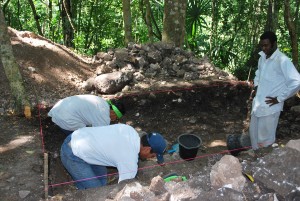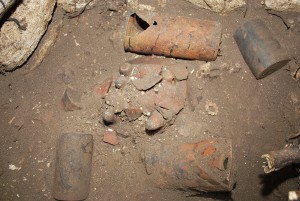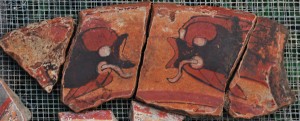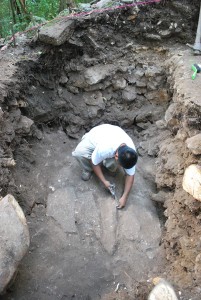Things got very busy this week. The excavations continued and we had at least one deposit every day, some of them quite memorable. Needless to say, we are accumulating a lot of laboratory work.
Excavation was begun in the final group selected for investigation, a small plazuela located south of Dos Aguadas in the flatlands. The group was nicknamed “Salsa.” It is relatively small and unassuming. Two trenches were placed axially to the north and the east buildings; the north building appears to be a pile of large boulders; lines-of-stone are visible in the east building.
The deeper trenches in Tango and the central areal excavation were finished by the end of this week. The trenches in the eastern and northern buildings were dug to bedrock. Apart from earlier plaza floors, no real construction features were in evidence in either of these mounded platforms. Artifactually, half of an Early Classic basal-flange polychrome bowl was recovered on bedrock beneath the eastern building, as well as most of a crude unslipped bowl – both providing a similar basal date for the use of this locus.
In Zumba, the western areal excavation was finished and the western building was planned. The axial trench in the northern building continued to go down on either side of the tree in the middle of the stairway. A series of plaster floors were recovered in the hearting of the north building, indicative of earlier constructions. The axial trench in the east building was perhaps the busiest, keeping 4 people (Amy, Carlos, Mo, and Max) well occupied all week. We finally entered and excavated the open tomb; by week’s end, the chamber had yielded some 38 ceramic vessels, a series of small artifacts, and not nearly enough bone for all of these materials. The excavation in front of this building kept finding cache after cache vessel, as well as obsidian eccentrics and limestone bars. The disturbed bones of a burial were also recovered, having been cut into repeatedly by the multitude of caching activity.
In Dos Aguadas, all four trenches and the areal excavation over the low structure in the plaza had sections done. Deeper excavation then proceeded in the western, northern, and eastern trenches. In the eastern trench, first a burnt finger bowl cache was found in the fill of the building and then, at a slightly deeper level, an open cist that was capped with a limestone slab and that contained a complete lidded face cache. The lid actually had preserved post-fire paint – a white underslip with two black circles. Lifting the lid produced cache contents similar to the marine contents found in the site’s main plazas. Not only were there shells (and rocks, like in many of Caracol’s other caches) but a host of stingray spines, fish vertebrae, and cache dirt (primarily jadeite and malachite chips); a jade bead formed the center of the assemblage.
In Terraza, the original areal excavation of the south structure was completed and an extension was made to obtain the interior plan of the building (suspected to be another interior bench on the eastern end of the structure). The axial penetration of the upper eastern building was completed by week’s end, stopping because of the size of the stone boulders that formed the deep fill. The core of this construction was full of sherds, including some well-preserved polychromes that we normally do not get at Caracol. The lower (northern) eastern building in Terraza also saw continued excavation with the removal of a burial in the plaza to the front of the building, the exposure of the latest steps, and a deeper cut at the summit. The summit excavation came down upon the capstones for a sealed chamber by week’s end. This will surely keep us occupied next week.











